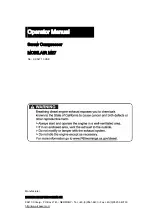
15
English
3. Drain air tank.
4. Allow air compressor to cool down before starting service.
note: All compressed air systems contain maintenance parts (e.g.,
oil, filters, separators) that are periodically replaced. These used parts
may contain substances that are regulated and must be disposed of in
accordance with local, state, and federal laws and regulations.
note: Take note of the positions and locations of parts during
disassembly to make reassembly easier.
note: Any service operations not included in this section should
be performed by a D
e
WALT factory service center or a D
e
WALT
authorized service center.
Maintenance Chart
Procedure
Daily
Weekly
see tank
warning label
Check safety valve
X
Inspect air filter
X
Drain air tank
X
Check for unusual noise/vibration
X
Check for air leaks
X
1
Clean compressor exterior
X
Remove tank from service
X
2
1 To check for air leaks apply a solution of soapy water around joints.
While compressor is pumping to pressure and after pressure cuts out,
look for air bubbles to form.
2 - For more information, call 1-800-4-D
e
WALT (1-800-433-9258)
Checking Safety Valve (Fig. 1)
WARNING: Risk of bursting. If the safety valve does not work
properly, overpressurization may occur, causing air tank rupture or
an explosion.
WARNING: Risk from flying objects. Always wear certified safety
equipment: ANSI Z87.1 eye protection (CAN/CSA Z94.3) with side
shields when using the compressor.
Before starting compressor, pull the ring on the safety valve to
make sure that the safety valve operates freely. note: Ring may
be difficult to pull when air tank pressure is at 0 psi. If the valve is
stuck or does not operate smoothly, it must be replaced with the
same type of valve.
Draining Air Tank (Fig. 1)
WARNING: Risk of unsafe operation. Risk from noise. Air tanks
contain high pressure air. Keep face and other body parts away from
outlet of drain. Use eye protection [ANSI Z87.1 (CAN/CSA Z94.3)]
when draining as debris can be kicked up into face.
WARNING: Risk from noise. Use ear protection [ANSI S12.6
(S3.19)] as air flow noise is loud when draining.
note: All compressed air systems generate condensate that
accumulates in any drain point (e.g. tanks, filter, aftercoolers, dryers).
This condensate contains lubricating oil and/or substances which
may be regulated and must be disposed of in accordance with local,
state, and federal laws and regulations.
1. Ensure Auto/Off switch is in the
OFF(O)
position.
2. Lift compressor into an inclined position so drain valve (B) is at
the lowest point (this will assist in removing moisture, dirt, etc.
from air tanks).
3. Place a suitable container under the drain valve to catch
discharge.
4. Grasp lever on drain valve.
5. Slowly rotate lever to gradually bleed air from air tank.
WARNING: Risk of bursting. Drain air tank daily. Water will con
dense in air tank. If not drained, water will corrode and weaken the
air tank causing a risk of air tank rupture.







































